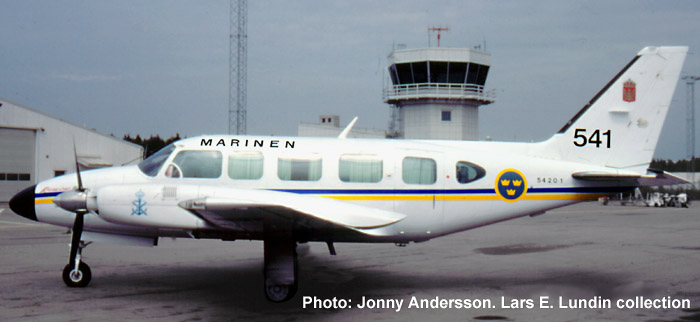|
Type 54B - Piper PA-31-350 Chieftain (1989-1997) |
||
|
|
Page 1 (of 1) |
|
|
|
||
The Piper PA-31 Chieftain is developed from the classic PA-31 Navajo variant. The Chieftain has a longer fuselage and a strengthened fuselage floor to allow loading of cargo pallets and is one of the most common aircraft in the class of short-range executive transports. Aircraft carrying the name Navajo are manufactured 1980 and earlier. Further developments are the Cheyenne - Piper’s first turboprop design- and the Mojave - with counter-rotating propellers. The PA-31 became a common commercial aircraft in Sweden at the beginning of the 1960s. 1989-1997, the Navy leased in total five aircraft from a private enterprise in Gothenburg. The main reason for the Navy to acquire the Chieftains was for training its most experienced helicopter pilots in instrument flight. The hourly cost for a twin-engine aeroplane is much lower than for a large helicopter. The training flights with the Chieftain were also often combined with transport of personnel and cargo for all parts of the Swedish defence. The story of the designation of the Chieftains is a bit complicated. At first, the aircraft got the Air Force designation Tp 45. But the Tp 45 designation was once used for the two Beechcraft C-45 transports in service 1948-1955. As this was regarded unsuitable, the designation was changed to TP 54. This was also a bit hasty as it collided with the FPL 54 (MFI 10-B Vipan), which was evaluated by the Army aviation 1963-1964. Thereafter, the Chieftains have been designated TP 54B or Type 54B. The three naval Helicopter Squadrons – Berga, Kallinge and Säve were provided with one Type 54B each in 1989. The 11th Squadron at Berga could only operate helicopters from their base near Stockholm. Instead, the aircraft was stationed at Bromma. The following year, two more machines were leased as spare aircraft. The five Type 54Bs got Air Force Numbers (54200 – 54204). At first, the aircraft kept their civil registration codes. After some time the letters ”SE” of the civil registration code on the aircraft were covered by national (”crown”) insignias. The three letters after ”SE-” became the individual letters of recognition. Regulations regarding ”the marking of temporarily leased aircraft” were issued. The Swedish Civil Aviation Administration did not like this arrangement and the regulations were soon cancelled. The odd ”civilian-military” marking disappeared and all aircraft, including the further two leased in 1990, got pure military markings. The aircraft had room for two pilots and 6-8 passengers. It had two Lycoming TIO-540-J2BD piston engines, each delivering 350 hp. Since the leasing contract expired, the Swedish Navy has only used helicopters for pilot training in the air. Photos: Top: # 54001 at Skövde May 1996. Bottom: # 54002 at Skövde, June 1996. Length: 10,56 m. Span: 12,40 m. MTOW: 3.175 kg. Max. speed: 436 km/h. The THFS - Trafikflyghögskolan (the Flying School) which are training pilots for the civil aviation at Ljungbyhed, uses Piper Navajo for twin-engine training. |
||
|
|
||
|
|
||
| © Lars Henriksson |
Updated 2010-07-15 |
|
|
|
||

